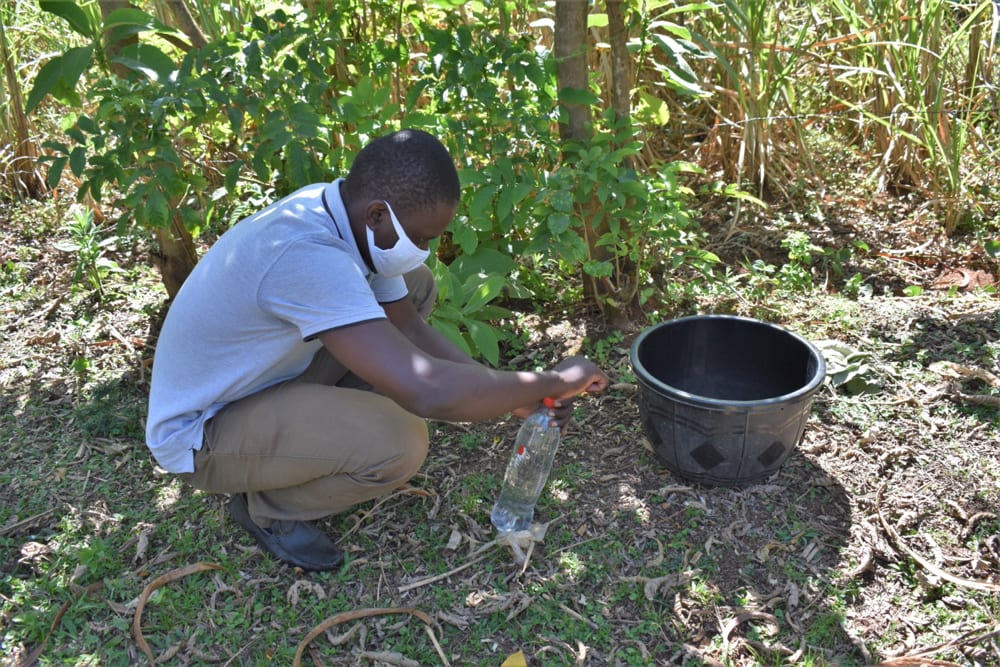Based in a rural set-up, Shamoni Village is in a sugar belt region with community members practicing large scale sugarcane farming as their main cash crop and livelihood. Most houses in the village are semi-permanent and grass-thatched with a majority not connected to electricity. Some community members are employed as casual laborers at the West Kenya Sugar Factory while others engage in running small businesses in the nearby town. People here are a united group who relate well to one another, and this has created a strong bond in the community.
Water being a precious commodity needed by all, 300 community members in Shamoni are forced to draw water from the unprotected Shatuma Spring as it is the only year-round water source in the area. Currently, water from the spring is not safe for drinking as the catchment area is exposed to runoff from the rains that seep into the ground. The runoff carries farm chemicals, animal waste residues, and soil into the spring water.
Community members report water-related infections such as cholera and typhoid among the families who depend on this spring. The medication and hospital visits often required of these illnesses are expensive, eating into families' financial resources. When they are home sick, adults miss work and lose income-earning time, while kids have to stay home from school and can start to fall behind in their classes.
Physical accessibility is another big concern at Shatuma Spring.
"Drawing water from the spring is a big challenge, especially to elderly persons. The spring has no stairs guiding one to the water point, thus making it difficult for such persons to access the spring. I have once hurt myself while trying to access the water point, forcing me to seek medical attention," said 60-year-old farmer Timothy Lucheri Ijendi.
At one point the spring was partially protected, but it was not done to standard and it quickly broke down. All that remains is the discharge pipe lodged directly into the earth and the open area where the spring's water originates. Without a complete catchment area, a lot of the spring's water flows around the pipe, slowing community members down as they wait for their jerrycans to fill.
"Over the holidays, I find it quite a big challenge accessing the spring. This is due to overcrowding at the spring since it is a tradition in our community that children have to allow the elder persons to first access the precious commodity," reported young primary school-aged student Francis.
To aid in fetching water, the community moved several stones and old cinderblocks below the pipe to try to stay above the constant pool of water while they fetch. But these are slippery and difficult to balance on, often ending up with people in the water anyway.
The drainage system is not well-constructed or maintained, leading to water stagnating at the collection area. This has been a great challenge when drawing water from the spring, as mosquitoes, snakes, and insects all prefer this wet environment and can be dangerous to the community members. This is especially true of mosquitoes carrying malaria that use the spring as a breeding ground.
What We Can Do:
Spring Protection
Protecting the spring will help provide access to cleaner and safer water and reduce the time people have to spend to fetch it. Construction will keep surface runoff and other contaminants out of the water. With the community’s high involvement in the process, there should be a good sense of responsibility and ownership for the new clean water source.
Fetching water is a task predominantly carried out by women and young girls. Protecting the spring and offering training and support will, therefore, help empower the female members of the community by freeing up more of their time and energy to engage and invest in income-generating activities and their education.
Training on Health, Hygiene, COVID-19, and More
To hold trainings during the pandemic, we work closely with both community leaders and the local government to approve small groups to attend training. We ask community leaders to invite a select yet representative group of people to attend training who will then act as ambassadors to the rest of the community to share what they learn. We also communicate our expectations of physical distancing and wearing masks for all who choose to attend.
The training will focus on improved hygiene, health, and sanitation habits in this community. We will also have a dedicated session on COVID-19 symptoms, transmission routes, and prevention best practices.
With the community’s input, we will identify key leverage points where they can alter their practices at the personal, household, and community levels to affect change. This training will help to ensure participants have the knowledge they need about healthy practices and their importance to make the most of their water point as soon as water is flowing.
Our team of facilitators will use a variety of methods to train community members. Some of these methods include participatory hygiene and sanitation transformation, asset-based community development, group discussions, handouts, and demonstrations at the spring.
One of the most important issues we plan to cover is the handling, storage, and treatment of water. Having a clean water source will be extremely helpful, but it is useless if water gets contaminated by the time it is consumed. We and the community strongly believe that all of these components will work together to improve living standards here, which will help to unlock the potential for these community members to live better, healthier lives.
We will then conduct a small series of follow-up trainings before transitioning to our regularly scheduled support visits throughout the year.
Training will result in the formation of a water user committee, elected by their peers, that will oversee the operations and maintenance of the spring. The committee will enforce proper behavior around the spring and delegate tasks that will help preserve the site, such as building a fence and digging proper drainage channels. The fence will keep out destructive animals and unwanted waste, and the drainage will keep the area’s mosquito population at a minimum.

 Protected Spring
Protected Spring
 Rehabilitation Project
Rehabilitation Project













































